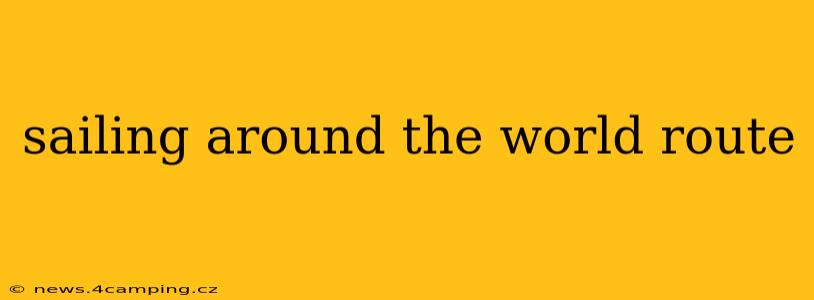The dream of circumnavigating the globe by sailboat is a powerful one, captivating adventurers and seasoned sailors alike. But planning such a journey requires meticulous preparation, careful route selection, and a deep understanding of oceanic conditions. This comprehensive guide delves into the intricacies of planning a world sailing route, addressing common questions and offering insights for a successful and safe circumnavigation.
What is the Best Route for Sailing Around the World?
There's no single "best" route for a world sailing trip; the ideal path depends heavily on your starting point, the time of year you plan to depart, your vessel's capabilities, and your personal preferences. Many sailors opt for routes that leverage prevailing winds and currents, minimizing time at sea and maximizing enjoyment. Popular routes often include the trade winds and the Roaring Forties, but factors like weather patterns, potential hazards, and desired destinations heavily influence the final itinerary.
What is the Fastest Route Around the World by Sailboat?
Speed records in sailing circumnavigation are constantly being challenged, with advancements in boat design and sailing techniques playing significant roles. However, speed isn't usually the primary goal for most circumnavigators. A fast route often involves prioritizing speed over safety and comfort, potentially cutting through less predictable weather systems. The fastest routes usually incorporate strategic use of the Southern Ocean's strong winds but expose sailors to more extreme conditions.
How Long Does It Take to Sail Around the World?
The time required for a circumnavigation varies drastically depending on the route chosen, the vessel's speed, and the number of stops planned along the way. A non-stop circumnavigation can take a dedicated team several months, pushing the limits of endurance and relying heavily on well-established weather routing strategies. More leisurely voyages, which incorporate stops in various ports for exploration, provisioning, and rest, could stretch over several years. The average time for a more relaxed, multi-stop circumnavigation is typically 1-3 years.
What are the Most Dangerous Parts of Sailing Around the World?
Several stretches of ocean pose significant challenges to circumnavigators:
- The Southern Ocean (Roaring Forties, Furious Fifties, Screaming Sixties): Known for its intense winds, large waves, and unpredictable weather patterns, this region demands a seaworthy vessel and experienced crew.
- The Drake Passage: Located between South America and Antarctica, this passage is notorious for its rough seas and strong currents.
- The Indian Ocean: This vast ocean can present challenges like unpredictable monsoons and potential pirate activity in certain areas.
- Cape Horn: This legendary cape at the southern tip of South America is known for its unpredictable winds and strong currents, posing a significant challenge for sailors.
What are the Costs of Sailing Around the World?
The costs associated with circumnavigating the globe are substantial and vary widely. Factors impacting the total expense include:
- Boat purchase or charter: The largest expense, ranging from tens of thousands to millions of dollars depending on the vessel's size and condition.
- Maintenance and repairs: Regular maintenance is crucial for long-distance voyages, and unexpected repairs can be expensive.
- Provisioning: Stocking up on food, water, and other essentials for an extended period adds up.
- Dockage and mooring fees: Costs associated with stopping in various ports.
- Insurance: Comprehensive insurance is a necessity for a journey of this magnitude.
Planning your sailing route around the world involves numerous considerations; factoring in all these elements allows for a safer, more enjoyable, and ultimately, more successful global sailing adventure. Remember that thorough preparation, continuous learning, and a respect for the power of the ocean are essential for any circumnavigation.
